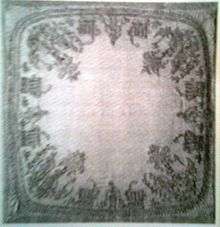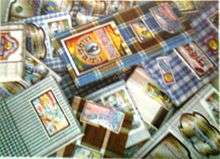Textile arts of Bangladesh
The history of the textile arts of Bangladesh dates back to the 1st century AD. According to the archaeological excavations, Bangladesh was once famous for its artistic textile production throughout the world. Over the years, several types of textiles evolved in the country, mostly by the indigenous handloom manufacturers.
History

The fine, transparent mulmul known as muslin in Europe manufactured by the weavers of Bengal was established as a commercial product almost 2000 years ago. Gangetic muslin is referred to by Greek and Roman writers. It is known from their writing that it was the most favored among the luxury goods imported from India. These were known by beautiful poetic names in Rome such as – nebula which means mist, vapor or cloud, and venti textiles, woven winds. Similar names are still used in Dhaka.
The most important commodities were fine cotton and, later, silk. The East India Company, already well established in Goa began to cast covetous glances at Bengal in the early 16th century. In 1536 they set up trading posts at Satgaon and Chittagong. In the mid – 17th century the East India company of London was permitted by the Mughal government to establish a few factories (trading posts) in Bengal.
The handloom textile industry employs a large section of the population. About 60 to 65 percent of the demand for textiles in Bangladesh is supplied by the handloom industry.[1]
Types
- Tant: From ancient times only persons from the Tanti caste worked on the loom. Weavers generally came into this profession from the Hindu Tanti or Kayastha castes.[2]
- Khadi: also known as "khaddar" has a long history in Bangladesh. In the 6th century a local variation of Khadi cloth was described by Huen Tsang of China and Marco Polo in the 12th century AD describes a fabrics, most probably khadi Muslin in the Bengal region to be as fine as the spider’s web.[3]
- Cotton: Watts and Brown mention that the cotton fabric of Bengal was manufactured in the regions of Burdwan, Birbhum, Bankura, Serampore, Nadia, Bogra, Pabna, Dhaka, Faridpur, Chittagong, etc. The muslin of Dhaka was renowned.[4]
- Rajshahi silk: There are three kind of silk found in Bangladesh, these are tassar silk, muga silk and eri silk.[5]
- Mixed Fabrics: As Islam forbids the use of pure silk garbs in religious ceremonies the artistic use of many mixed fibers was observed in the subcontinent. Mulberry silk and cotton mixes are called garbhasuti or asmani.
- Muslin: Durgadas Lahiri has mentioned in Bharatbarsher Itihas that in 1462 BC most mummies of Egypt were covered in muslins. In this context George Birdwood writes, ’filmy Muslin "comely as curtain of Solomon ," is even older than the code of Manu. The meaning of the word muslin is not clearly known.[6]
- Jamdani: Diversely ornamented muslin is called jamdani. The muslins that are loom – figured are called jamdani. It is the original loom.[7]

- Sari, Lungi and other garments: In rural Bangladesh the word sari and kapor mean the same thing. The sari has always been made in the same form. The word dhoti is derived from dhowa ("washing"). The word gamchha is derived from ga mocha (wiping the body). At present the lungi is the most popular wear for men.[8]

- Tangail: Tangail was celebrated for its looms from ancient times. The weavers of Bajitpur would manufacture a variety of high quality embroidered sari. The Tangail sari became a legend. These were produced under patronage of local zamindars. With the aim of organizing the weavers' caste and preserving the tradition of the Tangail sari, a central artisan's cooperative society was established at the end of the 1930s.

References
- ↑ Ahmad, Shamsuddin (2012). "Textiles". In Islam, Sirajul; Jamal, Ahmed A. Banglapedia: National Encyclopedia of Bangladesh (Second ed.). Asiatic Society of Bangladesh.
- ↑ Faroqi, Gofran (2012). "Tanti". In Islam, Sirajul; Jamal, Ahmed A. Banglapedia: National Encyclopedia of Bangladesh (Second ed.). Asiatic Society of Bangladesh.
- ↑ "Cosy Comfort: Khadi". bdnewslive.com. Archived from the original on 2014-01-14. Retrieved 2014-01-14.
- ↑ Ali, Md Ibrahim (2012). "Cotton". In Islam, Sirajul; Jamal, Ahmed A. Banglapedia: National Encyclopedia of Bangladesh (Second ed.). Asiatic Society of Bangladesh.
- ↑ Van Schendel, Willem (2012). "Silk". In Islam, Sirajul; Jamal, Ahmed A. Banglapedia: National Encyclopedia of Bangladesh (Second ed.). Asiatic Society of Bangladesh.
- ↑ Karim, Abdul (2012). "Muslin". In Islam, Sirajul; Jamal, Ahmed A. Banglapedia: National Encyclopedia of Bangladesh (Second ed.). Asiatic Society of Bangladesh.
- ↑ Banu, Zinat Mahrukh; Reza, Masood (2012). "Jamdani". In Islam, Sirajul; Jamal, Ahmed A. Banglapedia: National Encyclopedia of Bangladesh (Second ed.). Asiatic Society of Bangladesh.
- ↑ Khan, Shawal (2012). "Sari". In Islam, Sirajul; Jamal, Ahmed A. Banglapedia: National Encyclopedia of Bangladesh (Second ed.). Asiatic Society of Bangladesh.
Further reading
- Lala Rukh Selim (2007). Art and Crafts: Series 8. 8. Asiatic Society of Bangladesh.
- Social Dimensions of Economic Reforms in Bangladesh: Proceedings of the National Tripartite Workshop Held in Dhaka, Bangladesh, 18-20 May 1993. International Labour Organization. 1993. pp. 105–. ISBN 978-92-2-108987-2. Retrieved 8 September 2013.
- M. Lakshmi Narasaiah (1 January 1999). Crisis of Handloom Industry. Discovery Publishing House. pp. 109–. ISBN 978-81-7141-441-3. Retrieved 8 September 2013.
- Shahid Yusuf; Praveen Kumar (1 January 1996). Developing the Nonfarm Sector in Bangladesh: Lessons from Other Asian Countries. World Bank Publications. pp. 52–. ISBN 978-0-8213-3726-4. Retrieved 8 September 2013.
- Mahfuz R. Chowdhury (1 January 2004). Economic Exploitation of Bangladesh. iUniverse. pp. 58–. ISBN 978-0-595-30794-4. Retrieved 8 September 2013.
- The End of Textiles Quotas: A Case Study of the Impact on Bangladesh. International Monetary Fund. 1 June 2004. GGKEY:GNRDEL0PRQ5. Retrieved 8 September 2013.
- Cornelia Staritz (1 December 2010). Making the Cut?: Low-Income Countries and the Global Clothing Value Chain in a Post-Quota and Post-Crisis World. World Bank Publications. pp. 155–. ISBN 978-0-8213-8642-2. Retrieved 8 September 2013.
- G. K. Ghosh; Shukla Ghosh (1 January 1995). Indian Textiles: Past and Present. APH Publishing. pp. 53–. ISBN 978-81-7024-706-7. Retrieved 8 September 2013.
- Lex Heerma van Voss; Els Hiemstra-Kuperus; Elise van Nederveen Meerkerk (2010). The Ashgate Companion to the History of Textile Workers, 1650-2000. Ashgate Publishing, Ltd. pp. 615–. ISBN 978-0-7546-9591-2. Retrieved 8 September 2013.